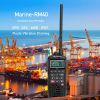AIS Overview

Its been several years since the Automatic Identification System (AIS) became a mandated way of life for the commercial side of the marine industry. it has become one of the more valuable electronics
In a nutshell, AIS is a seemingly simple system that transmits dynamic information about a vessels speed, course, and position plus static information including the vessels name, call sign, and Mobile Maritime Service Identity (MMSI) number over marine VHF frequencies . AIS receivers listen for that information as its sent by any AIS transceiver-equipped vessels that are in range, and AIS transceivers transmit and receive the data.

In actual practice, its far from simple. A fair bit of effort went into developing a protocol for a shipboard system, without any central control, that can manage data transmissions by an unknown number of vessels that appear and disappear at random. The result was a self-managing network that alternately transmits on two VHF channels, known as AIS 1 and AIS 2, using a system of automatically assigned time slots to prevent one vessels transmission from blocking another.
Initially, there was only a Class A AIS system intended for larger commercial vessels, but the recent introduction of a Class B system for small craft that do not need to meet the International Maritime Organizations (IMO) AIS requirements has changed the landscape significantly. The two systems are operationally similar but include important differences that affect the operational aspects of AIS interpretation. Most notable are the differences in transmit power, the type of data transmitted, and the requirement for Class B AIS to avoid interference with Class A systems.
If you want to know more about AIS, please contact us by Facebook, Twitter and Email. Our engineer will provide help to you.






